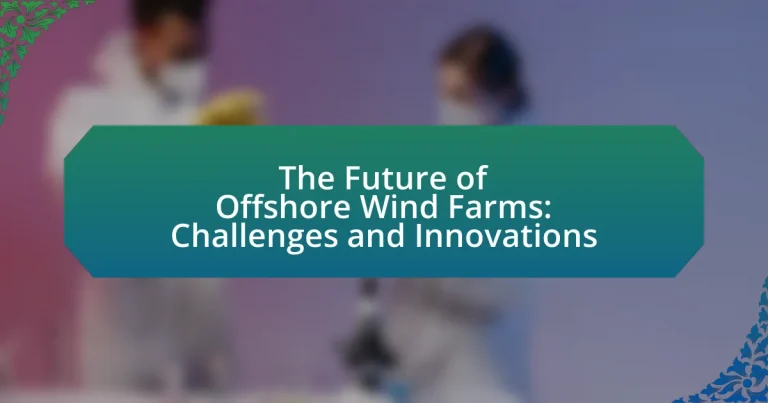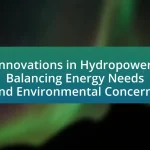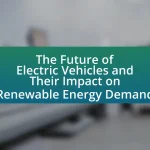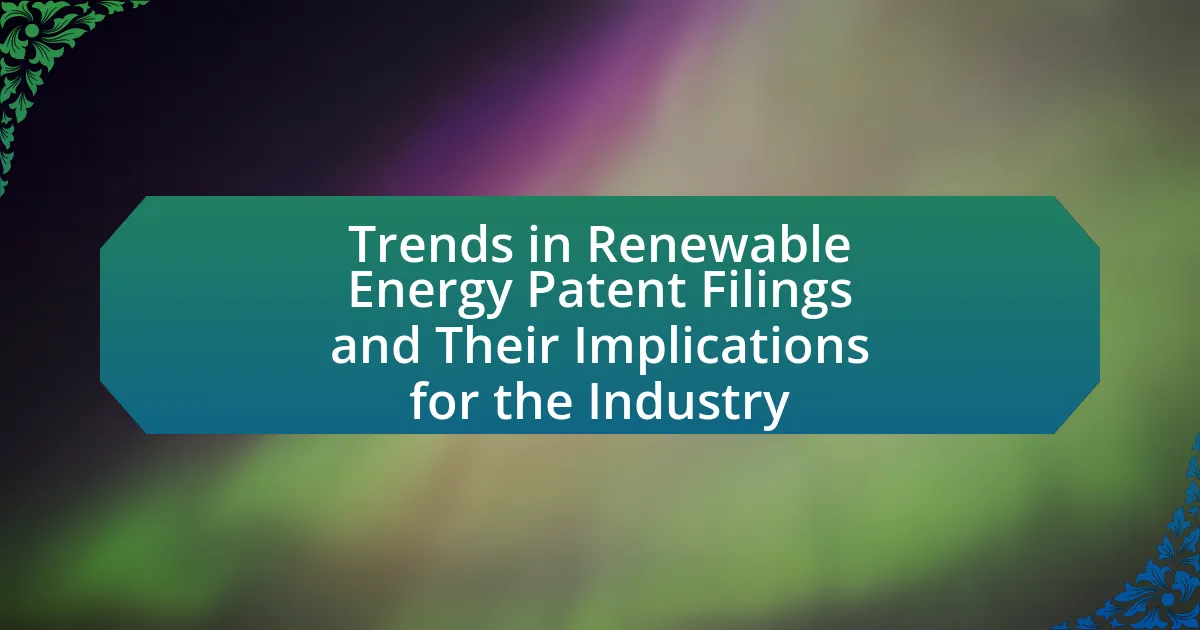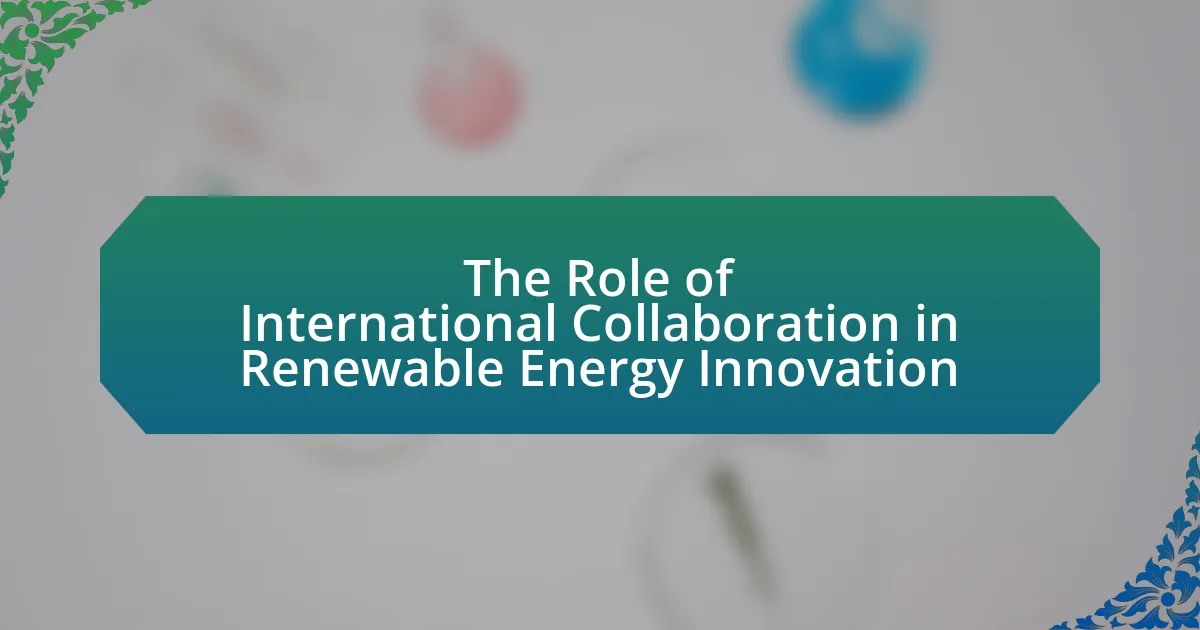Offshore wind farms are large-scale installations in marine environments that generate electricity from wind energy, playing a crucial role in the transition to renewable energy and reducing greenhouse gas emissions. The article explores the operational mechanisms of these farms, the technologies employed, and the environmental factors influencing their efficiency. It also addresses the economic benefits, challenges, and regulatory hurdles faced by offshore wind projects, while highlighting innovations such as floating turbines and digital technologies that enhance their viability. Additionally, the article discusses emerging financing models and best practices for successful offshore wind farm development, emphasizing their potential to contribute significantly to global energy needs and economic growth.
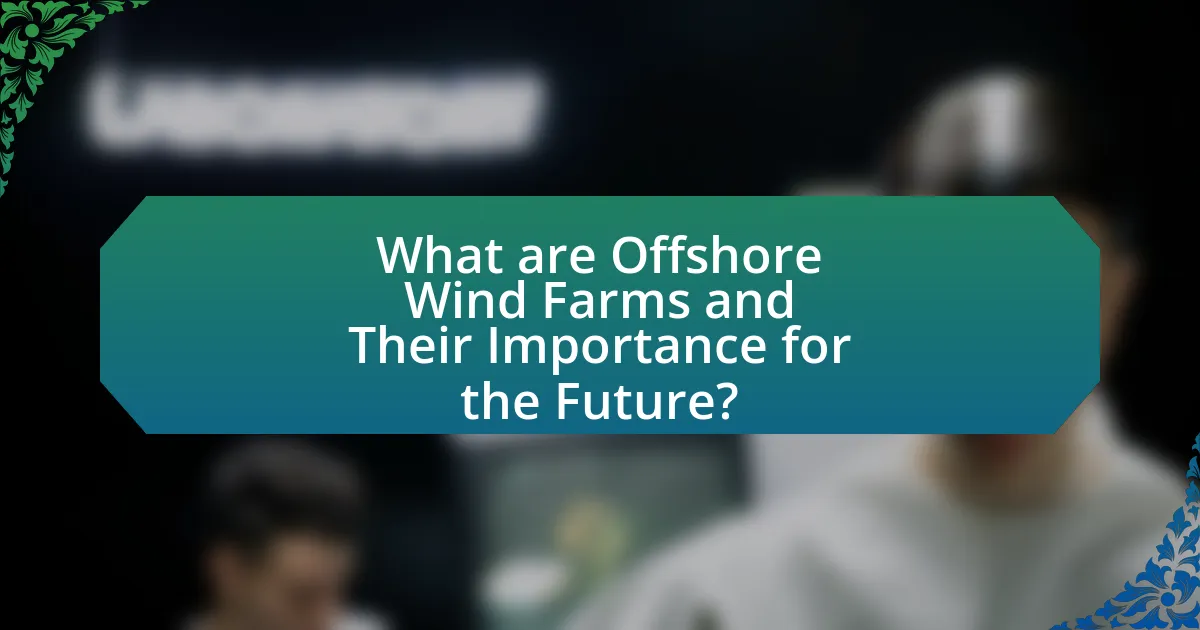
What are Offshore Wind Farms and Their Importance for the Future?
Offshore wind farms are large-scale installations located in bodies of water that harness wind energy to generate electricity. These farms are crucial for the future as they provide a renewable energy source that can significantly reduce greenhouse gas emissions and dependence on fossil fuels. According to the International Energy Agency, offshore wind capacity is projected to reach 234 gigawatts by 2030, highlighting its potential to contribute to global energy needs sustainably. Additionally, offshore wind farms can create jobs and stimulate economic growth in coastal regions, further emphasizing their importance in transitioning to a low-carbon economy.
How do Offshore Wind Farms operate?
Offshore wind farms operate by harnessing wind energy to generate electricity through turbines installed in bodies of water. These turbines convert kinetic energy from wind into mechanical energy, which is then transformed into electrical energy via generators. The electricity produced is transmitted to the shore through underwater cables, where it is integrated into the power grid.
According to the Global Wind Energy Council, as of 2021, offshore wind capacity reached over 35 gigawatts globally, demonstrating the technology’s growing significance in renewable energy production.
What technologies are used in Offshore Wind Farms?
Offshore wind farms utilize several key technologies, including wind turbines, floating platforms, and subsea cabling systems. Wind turbines, specifically designed for marine environments, convert wind energy into electricity, with advancements in turbine size and efficiency enhancing energy output. Floating platforms allow turbines to be placed in deeper waters, expanding the potential locations for wind farms. Subsea cabling systems transmit the generated electricity to the grid, ensuring efficient energy distribution. These technologies collectively contribute to the growing capacity and viability of offshore wind energy, which has seen a significant increase in global installations, reaching over 35 gigawatts by 2020, according to the Global Wind Energy Council.
How do environmental factors influence Offshore Wind Farm operations?
Environmental factors significantly influence Offshore Wind Farm operations by affecting energy production, equipment durability, and operational efficiency. For instance, wind speed and direction directly impact the amount of energy generated; optimal wind conditions can increase output, while low wind speeds can reduce it. Additionally, sea conditions, including wave height and water temperature, can affect the structural integrity of turbines and their maintenance schedules. Research indicates that extreme weather events, such as storms, can lead to increased downtime and repair costs, as evidenced by a study from the National Renewable Energy Laboratory, which found that offshore wind farms in harsher climates experience 20% more maintenance issues. Furthermore, marine ecosystems and wildlife considerations can impose operational restrictions, such as seasonal shutdowns to protect migratory species, thereby influencing overall productivity.
What are the key benefits of Offshore Wind Farms?
Offshore wind farms provide significant benefits, including the generation of renewable energy, reduction of greenhouse gas emissions, and creation of jobs. These farms harness strong and consistent winds over the ocean, which allows for higher energy output compared to onshore wind farms. According to the Global Wind Energy Council, offshore wind capacity reached 35 gigawatts globally by the end of 2020, demonstrating its growing role in sustainable energy production. Additionally, offshore wind projects can stimulate local economies by creating thousands of jobs in manufacturing, installation, and maintenance, contributing to economic growth in coastal regions.
How do Offshore Wind Farms contribute to renewable energy goals?
Offshore wind farms significantly contribute to renewable energy goals by generating large amounts of clean electricity from wind resources located at sea. These installations harness stronger and more consistent wind speeds compared to onshore sites, resulting in higher energy output. For instance, according to the Global Wind Energy Council, offshore wind capacity reached 35 gigawatts globally in 2020, with projections estimating it could supply up to 10% of the world’s electricity by 2030. This substantial energy production aids in reducing greenhouse gas emissions and reliance on fossil fuels, aligning with international climate targets such as the Paris Agreement.
What economic advantages do Offshore Wind Farms provide?
Offshore wind farms provide significant economic advantages, including job creation, reduced energy costs, and increased energy independence. The construction and maintenance of these facilities generate thousands of jobs in manufacturing, installation, and operations; for instance, a report from the U.S. Department of Energy indicates that the offshore wind sector could support over 77,000 jobs by 2030. Additionally, offshore wind farms can lower energy prices by providing a stable and renewable energy source, which can reduce reliance on fossil fuels and mitigate price volatility. Furthermore, they enhance energy independence by diversifying the energy supply, reducing vulnerability to geopolitical tensions associated with fossil fuel imports.
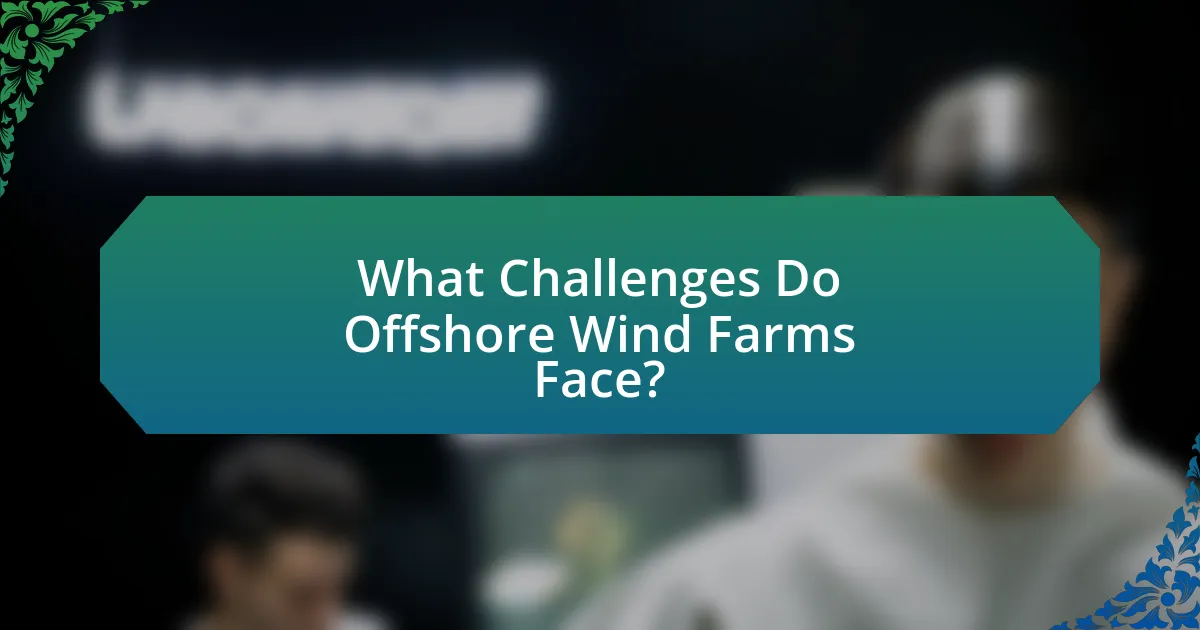
What Challenges Do Offshore Wind Farms Face?
Offshore wind farms face several significant challenges, including high installation and maintenance costs, environmental impacts, and regulatory hurdles. The installation of offshore wind turbines requires specialized vessels and equipment, leading to increased capital expenditure; for instance, the cost of offshore wind energy projects can exceed $6,000 per installed kilowatt. Environmental concerns arise from potential impacts on marine ecosystems and bird migration patterns, necessitating thorough environmental assessments. Additionally, regulatory frameworks can vary significantly by region, complicating the permitting process and potentially delaying project timelines. These challenges collectively hinder the rapid expansion and efficiency of offshore wind energy development.
What are the technical challenges in developing Offshore Wind Farms?
The technical challenges in developing offshore wind farms include harsh environmental conditions, high installation and maintenance costs, and complex grid integration. Offshore wind farms must withstand extreme weather, including high winds and waves, which can complicate construction and operation. The costs associated with installation are significantly higher than onshore due to the need for specialized vessels and equipment, with estimates indicating that offshore wind projects can be 1.5 to 2 times more expensive than their onshore counterparts. Additionally, integrating offshore wind energy into existing power grids poses challenges related to transmission efficiency and stability, as offshore locations are often far from demand centers. These factors collectively hinder the rapid deployment and scalability of offshore wind energy projects.
How does the harsh marine environment affect Offshore Wind Farm construction?
The harsh marine environment significantly impacts Offshore Wind Farm construction by introducing challenges such as extreme weather conditions, strong currents, and corrosive saltwater. These factors necessitate specialized engineering solutions and construction techniques to ensure the structural integrity and longevity of wind turbines. For instance, construction vessels must be equipped to operate in rough seas, and materials used must be resistant to corrosion, which can increase costs and extend project timelines. Additionally, the presence of high winds and waves can limit the operational window for installation, leading to delays. According to a study by the National Renewable Energy Laboratory, these environmental conditions can increase the overall cost of offshore wind projects by up to 20%.
What are the challenges related to maintenance and operation?
The challenges related to maintenance and operation of offshore wind farms include harsh environmental conditions, logistical difficulties, and high operational costs. Harsh weather, such as strong winds and rough seas, complicates access for maintenance crews and equipment, leading to increased downtime. Logistical difficulties arise from the remote locations of these farms, making transportation of personnel and spare parts challenging and time-consuming. High operational costs stem from the need for specialized vessels and equipment to perform maintenance tasks safely and effectively, which can significantly impact the overall economic viability of offshore wind projects.
What regulatory and policy challenges impact Offshore Wind Farms?
Regulatory and policy challenges impacting offshore wind farms include complex permitting processes, inconsistent state and federal regulations, and limited grid infrastructure. The permitting process often involves multiple agencies, leading to delays and increased costs; for instance, the Bureau of Ocean Energy Management (BOEM) oversees leasing, while state agencies manage environmental reviews. Additionally, regulations can vary significantly between states, creating uncertainty for developers. Furthermore, inadequate grid infrastructure can hinder the connection of offshore wind farms to the mainland, complicating project viability. These challenges collectively affect the speed and feasibility of offshore wind energy deployment, as evidenced by the slower-than-expected growth in the sector compared to other renewable energy sources.
How do government policies influence Offshore Wind Farm development?
Government policies significantly influence Offshore Wind Farm development by establishing regulatory frameworks, providing financial incentives, and setting renewable energy targets. These policies create a conducive environment for investment and innovation in offshore wind technology. For instance, countries like Germany and the United Kingdom have implemented feed-in tariffs and Contracts for Difference, which guarantee fixed prices for electricity generated from offshore wind, thus attracting substantial private investment. Additionally, streamlined permitting processes and government-backed research initiatives facilitate faster project approvals and technological advancements, as seen in the U.S. with the Biden administration’s commitment to deploying 30 gigawatts of offshore wind by 2030. Such policies not only enhance the economic viability of offshore wind projects but also align them with national energy goals, thereby accelerating their development.
What are the permitting challenges faced by Offshore Wind Farms?
Offshore wind farms face several permitting challenges, primarily related to regulatory complexities, environmental assessments, and stakeholder engagement. The regulatory framework for offshore wind development often involves multiple federal, state, and local agencies, which can lead to lengthy approval processes. Environmental assessments are required to evaluate the potential impacts on marine ecosystems, which can complicate and delay permitting. Additionally, engaging with stakeholders, including local communities and fishing industries, is crucial but can introduce further challenges as differing interests must be reconciled. These factors contribute to the overall difficulty in obtaining timely permits for offshore wind projects.
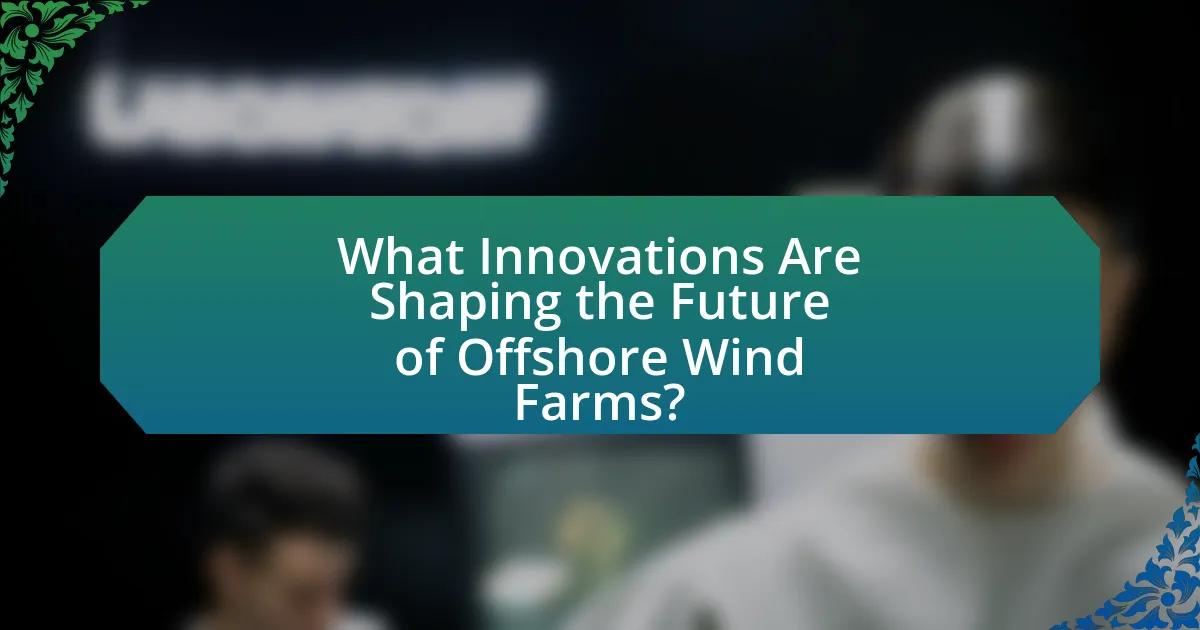
What Innovations Are Shaping the Future of Offshore Wind Farms?
Innovations shaping the future of offshore wind farms include larger turbine designs, floating wind technology, and advanced energy storage systems. Larger turbines, such as those exceeding 12 MW, increase energy output and efficiency, enabling the generation of more electricity per installation. Floating wind technology allows turbines to be placed in deeper waters, expanding the potential locations for wind farms and harnessing stronger winds. Advanced energy storage systems, including lithium-ion batteries and pumped hydro storage, enhance grid stability by storing excess energy generated during peak production times. These innovations collectively contribute to the growth and sustainability of offshore wind energy, addressing challenges related to energy demand and environmental impact.
How is technology advancing Offshore Wind Farm efficiency?
Technology is advancing offshore wind farm efficiency through innovations in turbine design, predictive maintenance, and energy management systems. Modern turbines, such as those developed by Siemens Gamesa and GE Renewable Energy, feature larger rotor diameters and higher capacity factors, enabling them to capture more wind energy and convert it into electricity more effectively. For instance, GE’s Haliade-X turbine has a capacity of 13 MW and can generate 67 GWh annually, enough to power 16,000 homes.
Additionally, predictive maintenance technologies, utilizing IoT sensors and machine learning algorithms, allow for real-time monitoring of turbine performance, reducing downtime and maintenance costs. A study by the National Renewable Energy Laboratory found that predictive maintenance can decrease operational costs by up to 30%.
Energy management systems optimize the integration of offshore wind energy into the grid, enhancing reliability and efficiency. These advancements collectively contribute to a more sustainable and economically viable offshore wind energy sector.
What role do floating wind turbines play in Offshore Wind Farm innovation?
Floating wind turbines are pivotal in advancing offshore wind farm innovation by enabling energy generation in deeper waters where traditional fixed-bottom turbines are not feasible. Their design allows for installation in locations with higher and more consistent wind speeds, significantly increasing energy output potential. According to the International Energy Agency, floating wind technology can unlock an estimated 80% of the global offshore wind resource, which is currently inaccessible with conventional systems. This innovation not only expands the geographical range for offshore wind farms but also enhances the overall efficiency and sustainability of renewable energy production.
How are digital technologies enhancing Offshore Wind Farm operations?
Digital technologies are enhancing Offshore Wind Farm operations by improving efficiency, monitoring, and maintenance through advanced data analytics and automation. For instance, predictive maintenance powered by machine learning algorithms allows operators to anticipate equipment failures, reducing downtime and maintenance costs. According to a report by the International Renewable Energy Agency, the integration of digital tools can increase operational efficiency by up to 20%. Additionally, real-time monitoring systems enable operators to optimize energy production by adjusting to changing environmental conditions, thereby maximizing output. These advancements demonstrate that digital technologies are crucial for the sustainable and efficient operation of offshore wind farms.
What innovative financing models are emerging for Offshore Wind Farms?
Innovative financing models emerging for offshore wind farms include green bonds, power purchase agreements (PPAs), and community investment schemes. Green bonds are debt instruments specifically earmarked for funding environmentally friendly projects, allowing investors to support renewable energy while receiving fixed returns. Power purchase agreements provide long-term contracts between energy producers and buyers, ensuring stable revenue streams for developers and reducing financial risk. Community investment schemes enable local stakeholders to invest directly in offshore wind projects, fostering public support and enhancing local economic benefits. These models are gaining traction as they address the high capital costs and financial risks associated with offshore wind development, evidenced by the increasing number of projects financed through these mechanisms globally.
How do public-private partnerships benefit Offshore Wind Farm projects?
Public-private partnerships (PPPs) benefit offshore wind farm projects by facilitating access to capital, sharing risks, and enhancing project efficiency. These collaborations enable private companies to leverage public funding and resources, which can significantly reduce the financial burden associated with large-scale offshore wind developments. For instance, the UK government has supported offshore wind through contracts for difference (CfDs), which guarantee a fixed price for electricity, thus attracting private investment. Additionally, PPPs can streamline regulatory processes and foster innovation by combining the strengths of both sectors, leading to faster project deployment and improved technological advancements.
What are the implications of green bonds for Offshore Wind Farm funding?
Green bonds significantly enhance funding for offshore wind farms by providing a dedicated source of capital aimed at environmentally sustainable projects. These financial instruments attract a growing pool of investors focused on sustainability, as evidenced by the global green bond market reaching over $1 trillion in issuance by 2021, according to the Climate Bonds Initiative. This influx of capital enables offshore wind projects to secure financing at potentially lower interest rates, thereby reducing overall project costs and improving financial viability. Furthermore, the issuance of green bonds often requires adherence to strict environmental standards, which can lead to improved project design and execution, ultimately contributing to the growth and efficiency of the offshore wind sector.
What best practices can be adopted for successful Offshore Wind Farm projects?
Successful Offshore Wind Farm projects can be achieved by adopting best practices such as thorough site assessment, stakeholder engagement, and advanced technology integration. Thorough site assessment involves evaluating wind resources, seabed conditions, and environmental impacts to ensure optimal turbine placement and minimize ecological disruption. Stakeholder engagement is crucial for gaining support from local communities, regulatory bodies, and investors, which can facilitate smoother project execution and compliance with regulations. Advanced technology integration, including the use of floating wind turbines and digital monitoring systems, enhances efficiency and reduces operational costs. For instance, according to the International Renewable Energy Agency, offshore wind capacity has grown significantly, with projects employing innovative technologies leading to cost reductions of up to 50% since 2010. These practices collectively contribute to the successful development and operation of offshore wind farms.
